|
Report from
Europe
EU tropical wood trade up 16% in the first half of 2019
The EU¡¯s trade in tropical wood products was more
buoyant in the first half of this year compared to the same
period in 2018.
Total imports of all wood products (classified in HS
Chapter 44) from tropical countries in the first half of
2019 were 1.24 million metric tonnes (MT), 16% more
than the same period in 2018. Import value increased 15%
to €1.26 billion.
This growth is surprising given that the wider economic
situation in the EU has continued to deteriorate this year.
In the European Central Bank (ECB)¡¯s latest projections,
published in September 2019, the euro-area is forecast to
grow only 1.1% in 2019 and 1.2% in 2020. This compares
to the ECB¡¯s December 2018 forecast of 1.7% growth in
both 2019 and 2020.
According to ECB, ¡°recent data and forward-looking
indicators ¨C such as new export orders in [eurozone]
manufacturing ¨C do not show convincing signs of a
rebound in growth in the near future and the balance of
risks to the growth outlook remains tilted to the
downside¡.The longer the weakness in manufacturing
persists, the greater the risks that other sectors of the
economy will be affected by the slowdown¡±.
The ECB observe that the trade war and other geopolitical
factors are affecting European output and economic
confidence, especially the manufacturing sector. As a
result, Germany is ¡°one of the euro area members most
affected by the slowdown¡±, given the importance of its
manufacturing sector which contributes 39% of German
GDP (compared to the eurozone average of 28%).
In response to the latest slowdown, in September the ECB
unveiled a package of stimulus measures including: a cut
in interest rates charged on bank deposits at the ECB, to -
0.5% to encourage lending; a pledge to maintain the
ECB¡¯s headline borrowing interest rate at zero indefinitely
and at least until there is a robust rise in inflation; and a
commitment to restart the ECB¡¯s quantitative easing
programme with €20bn of bond purchases each month
from November 2019.
For long-standing political reasons, Germany has a strong
commitment to a balanced budget and is very reluctant to
implement any stimulus measures leading to additional
government borrowing.
However, on 20 September Germany unveiled a euro 54
billion (US$60 billion) package over the next four years,
ostensibly to speed up the country's transition to renewable
energy and reduce carbon emissions, but widely
interpreted as part of underlying effort to support the ailing
growth.
The German package, which contains a mechanism for
monitoring progress on reaching emissions goals, may
provide new opportunities for timber products, but that
depends on the industry investing time and effort in
acquiring the necessary carbon footprint data and getting
its carbon messaging right.
At present, prospects for the UK economy appear no better
than in euro-zone countries, in fact likely even worse
given on-going political challenges. On 16 September, the
British Chambers of Commerce (BCC) released its latest
economic forecast, downgrading growth expectations for
the UK in 2019 to 1.2% (from 1.3% forecast in June 2019)
and to 0.8% (from 1.0%) for 2020.
While the BCC expects the UK economy to avoid a
technical recession and return to modest growth in the
third quarter, downgrades to its GDP growth forecast for
2019 and 2020 reflect a weaker outlook for investment,
trade and productivity amid a continued lack of clarity
over the outcome of Brexit and deteriorating global
economic conditions.
To some extent the rise in EU tropical wood imports in the
first half of 2019 is only a reflection of just how poor the
market was last year when imports for several
commodities barely exceeded the record lows of the 2008-
2009 financial crises.
Nevertheless, it is encouraging that the rise in EU imports
so far this year has been consistent across nearly all
tropical wood product groups (Chart 1). It also accords
with anecdotal reports, from interviews with European
importers, of generally robust trading conditions in the
first six months, at least in some sectors, notably sawn
hardwood.
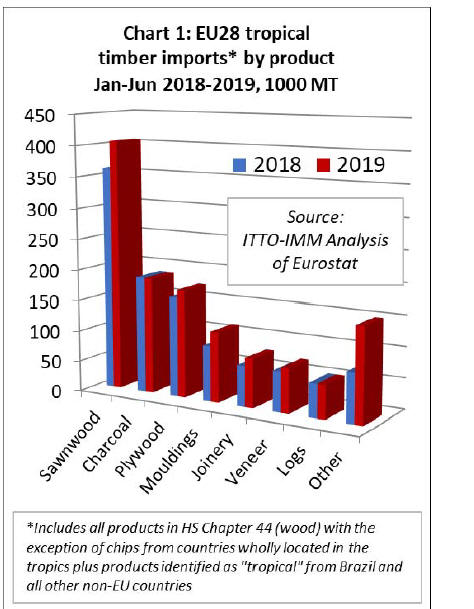
The latest upturn in imports is also quite well distributed
across the EU with imports of tropical wood products
higher during the first quarter in all the leading EU
markets except Germany and Poland.
In the first half of 2019 compared to the same period in
2018, total imports of tropical wood products increased in
Belgium (+20% to 257,400 MT), the UK (+14% to
187,600 MT), Netherlands (+12% to 154,000 MT), France
(+13% to 164,700 MT), Italy (+42% to 128,800 MT),
Spain (+28% to 62,400 MT), Portugal (+38% to 46,700
MT) and Greece (+8% to 38,300 MT).
In contrast, total first half 2019 imports of tropical wood
products in Germany declined 9% to 42,400 MT and 7%
in Poland to 34,900 MT. The decline in Germany is partly
driven by increasing reliance on indirect imports of
tropical wood products from other EU countries by
German distributors.
Rise in EU imports of tropical sawnwood
EU imports of tropical sawn wood increased 12% to
405,600 MT in the first half of 2019 compared to the same
period in 2018. Import value increased 7% to €388.4
million. This aligns with market commentary earlier in
the year, with sawn hardwood importers reporting
generally steady, in some cases strong trading in 2019
including in tropical timber, despite some slowdown in
economic activity and increased downside concerns about
the medium-term outlook.
During the first half of 2019, EU businesses reported some
issues with supply, but overall consumption was holding
up while sawn hardwood prices were steady to firm with
demand underpinned by construction sector consumption.
Imports from Cameroon, particularly slow in the first half
of last year, increased 20% to 141,000 MT during the first
six months of 2019.
Imports also increased sharply from several other
countries including Brazil (up 47% to 77,600 MT), Gabon
(up 20% to 58,600 MT), Congo (up 38% to 30,200 MT),
Ghana (up 17% to 8,800 MT) and DRC (up 32% to 7,300
MT). These gains offset a 29% decline in imports from
Malaysia, to 40,900 MT, and a 4% decline from Côte
d'Ivoire, 14,200 MT. (Chart 2).

The trend towards increased concentration of tropical
sawn wood imports into the EU by way of Belgium has
continued this year. In the first half of 2019 compared to
the same period in 2018, imports into Belgium increased
21% to 145,900 MT. Imports also increased in France (up
9% to 48,200 MT), the UK (up 21% to 29,800 MT), Spain
(up 67% to 27,570 MT) and Portugal (+53% to 15,200
MT). However, imports fell 14% to 67,100 MT in
Netherlands, 8% to 32,500 MT in Italy, and 7% to 12,600
MT in Germany. (Chart 3).
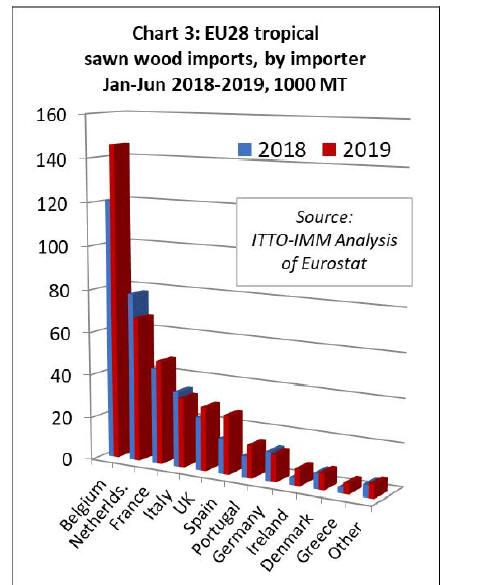
The decline in EU imports from Malaysia this year was
attributed by some importers to a decline in the availability
of PEFC certified product following the suspension of
MTCS certification in Johor and Kedah states led to the
total certified area in Malaysia to fall by around 25%.
According to MTCS, both states are now working to
regain their MTCS certificates.
There was a 40% fall in imports of Malaysian sawn
hardwood in the Netherlands, the leading EU destination
for Malaysian timber where there is also a particularly
strong emphasis on sourcing certified product.
Republic of Congo increasing focus for EU log imports
After recovering a little ground in 2018, EU imports of
tropical logs maintained the level of the previous year in
the first half of 2019. Imports of 54,400 MT during the
first half of the year were 0.3% more than the same period
in 2018. Import value fell 3% to €26.2 million during the
period.
While EU imports of tropical logs increased by 41% to
17,400 MT from Congo, the leading supplier, and by 48%
from Liberia, to 5,300 MT, these gains were offset by
falling imports from the Central African Republic (-7% to
9,500 MT), DRC (-29% to 7,100 MT), Cameroon (-14%
to 7,000 MT), Equatorial Guinea (-49% to 2,900 MT), and
Suriname (-19% to 1000 MT) (Chart 4).

After a slow start to the year, tropical log imports picked
up pace in France and Belgium in the second quarter of
2019. By the end of the first half, France had imported
22,800 MT of tropical logs, 3% more than the same period
in 2018, while imports into Belgium were up 9%, at
14,600 MT.
However, in the first six months of 2019, imports were
down 15% to 6,800 MT in Portugal, 12% to 4,800 MT in
Italy and 78% to 1,700 MT in the Netherlands.
Sharp rise in EU tropical moulding imports
EU imports of tropical mouldings (which includes both
interior mouldings and exterior decking products)
increased sharply, by 26%, to 114,100 MT in the first half
of 2019. Import value increased 37% to €173.5 million.
EU imports of tropical mouldings increased from all the
leading suppliers of this commodity in the first half of
2019 including Brazil (+28% to 48,200 MT), Indonesia
(+19% to 37,600 MT), Peru (+27% to 6,700 MT),
Malaysia (+23% to 6,900 MT), Gabon (+85% to 4,200
MT) and Bolivia (+55% to 4,200 MT) (Chart 5).
Although most of the Brazilian hardwood moulding
product imported into the EU is likely to consist of
tropical hardwood, a proportion will be ¡°lyptus¡±,
comprising plantation grown eucalyptus, which some
European importers are known to stock and to offer as a
PEFC certified product.
In the first half of 2019, imports of tropical mouldings
increased in all the leading EU markets including France
(+37% to 36,500 MT), Germany (+9% to 20,800 MT),
Netherlands (+51% to 19,400 MT), Belgium (+1% to
16,000 MT), the UK (+56% to 6,900 MT), and Italy
(+20% to 4,900 MT).
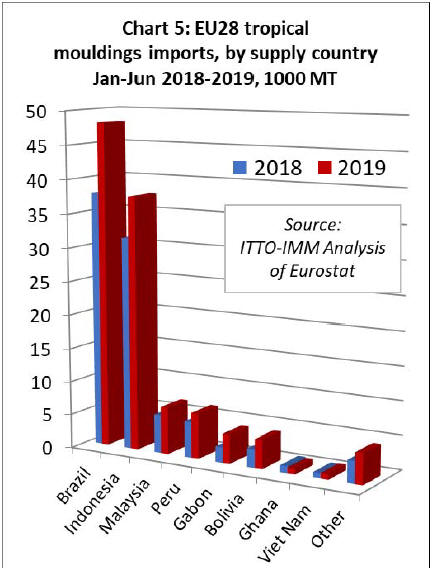
Tropical Asian suppliers make gains in EU joinery
market
EU imports of tropical joinery products, mainly doors
(from Indonesia), and laminated window scantlings and
kitchen tops (from all leading tropical suppliers), increased
21% to 79,500 MT in the first half of 2019. Import value
increased 33% to €166 million.
EU imports of tropical mouldings increased in the first
half of 2019 from all three of the countries that dominate
international trade in tropical joinery products including
Indonesia (+16% to 43,500 MT), Malaysia (+39% to
23,000 MT), and Viet Nam (+7% to 7,400 MT) (Chart 6).
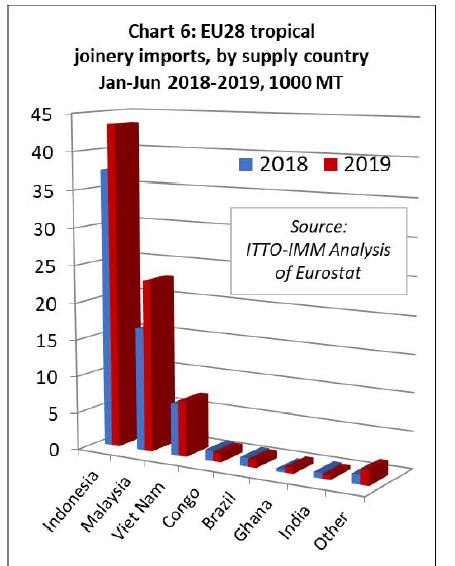
In the first half of 2019, imports of tropical joinery
products increased by 5% to 32,400 in the UK, by 129% to
24,800 MT in the Netherlands, and by 4% to 9,600 MT in
Belgium. There were also significant gains in two smaller
markets for tropical joinery products, Ireland increasing
87% to 1,600 MT and Poland up 58% to 800 MT. These
gains offset a 26% fall in France to 5,300 MT, and a 24%
fall in Germany to 3,300 MT.
EU imports of tropical plywood made in China
continue to increase
EU imports of tropical plywood products were 174,200
MT in the first half of 2019, 8% more than the same
period last year. Import value increased 14% to €154.4
million.
A large and growing proportion of the plywood faced with
tropical hardwood imported into the EU is manufactured
in China. The EU imported 76,100 MT of this product
from China in the first half of 2019, 39% more than during
the same period in 2018.
Imports also increased from Gabon, by 9% to 7,400 MT,
Viet Nam, by 3% to 6,100 MT, and Brazil, by 9% to 6,000
MT. These gains offset a 4% fall in imports from
Indonesia, to 46,300 MT, and 32% fall from Malaysia, to
19,700 (Chart 7).
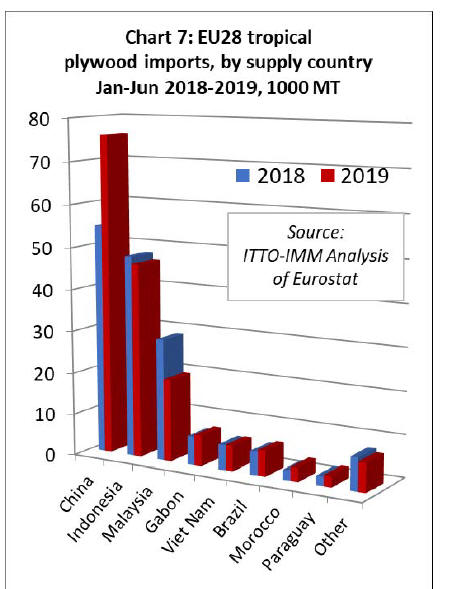
EU imports of tropical hardwood plywood during 2019 are
being strongly influenced by market issues elsewhere in
the world, notably the US-China trade dispute which has
led to a dramatic decline in Chinese hardwood plywood
exports to the United States and increasing diversion of
Chinese product to the EU, mainly destined for the UK.
In the first half of 2019, UK imports of tropical plywood
products increased 17% to 95,400 MT, despite widespread
reports of overstocking and declining plywood
consumption in the country. UK imports of tropical
hardwood plywood from China increased 81% to 55,000
MT in the first six months of 2019, while UK imports
from Malaysia fell 32%, to 16,800 MT, and were down
14% from Indonesia to 17,800 MT.
Tropical plywood imports into other EU countries were
less volatile in the first half of 2019. Moderate declines in
imports in Belgium (-8% to 19,100 MT), Germany (-3% to
13,000 MT), France (-3% to 10,100 MT) and Italy (-2% to
8,800 MT) were offset by an 8% rise in imports in the
Netherlands, to 18,500 MT. (Chart 8).
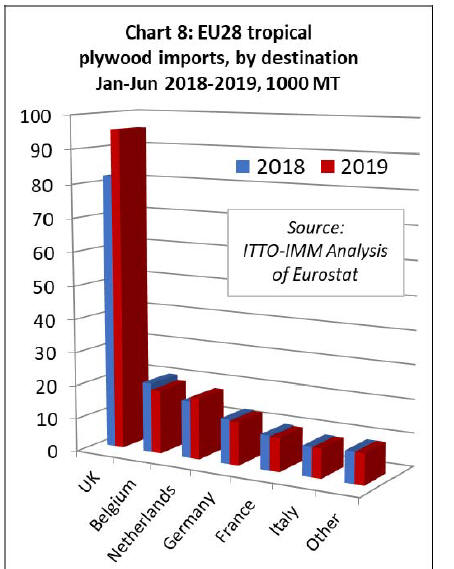
EU imports of tropical veneer up 11%
EU imports of tropical veneer increased 10% to 71,900
MT in the first half of 2019 compared to the same period
last year. Import value increased 9% to €92.3 million.
The EU imported 31,300 MT of veneer from Gabon in the
first half of 2019, 10% more than in the same period in
2018. Imports from Cameroon rose sharply, by 30% to
10,700 MT, after a poor year in 2018. There was also a
significant increase in imports from DRC, by 143% to
1,900 MT in the first half of 2019. (Chart 9)
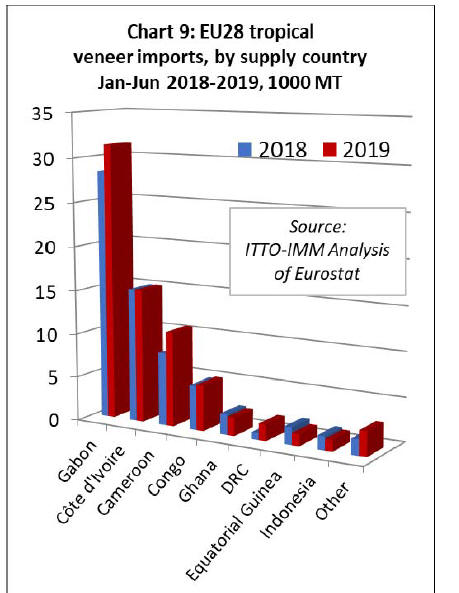
Imports from the Congo Republic were up 3% during the
same period, at 5,200 MT. Imports from Cote d¡¯Ivoire
were stable at 15,200 MT, while imports from Ghana
declined 10% to 2,100 MT and imports from Equatorial
Guinea fell 31% to 1,400 MT..
In the first half of 2019, tropical veneer imports increased
by 20% in France, to 27,400 MT, by 22% in Italy, to
18,900 MT, and by 48% in Greece to 5,500 MT. However,
imports fell by 17% in Spain, to 9,600 MT.
The recent slight recovery in EU imports of tropical
hardwood veneer and logs may be linked to a minor
recovery in EU domestic production of plywood with a
tropical hardwood face.
Although EU manufacturing of this product fell sharply in
the 2005-2015 period as controls on log exports were
introduced in Gabon and other African countries, and with
the influx of large volumes of cheap product from China,
there is evidence of a small upturn in production since
2015.
According to Eurostat, EU production of tropical
hardwood plywood increased from 315,000 m3 in 2016, to
409,000 m3 in 2017 and 446,000 m3 in 2018. This
comprised 177,000 m3 in Spain (10% less than in 2017),
114,000 m3 in France (+6%), 123,000 m3 in Italy (+54%)
and 31,000 m3 in Estonia (+32%).
EU imports of tropical charcoal level off in 2019
Between 2015 and 2018, the value of EU charcoal imports
increased from around €225 million to US$280 million,
almost exactly half of which derives from tropical
countries. However, the rising trend slowed in the first half
of 2019, with EU import value of tropical charcoal
reaching €74 million, only 3% more than the same period
in 2018.
EU import quantity of tropical charcoal declined 0.3% to
187,900 MT in the first half of 2019. While there was a
38% increase in imports from Cuba, to 43,800 MT, and a
13% gain from Venezuela, to 5,900 MT, this was offset by
declining imports from Nigeria (-4% to 81,200 MT),
Indonesia (-12% to 24,600 MT), and Paraguay (-34% to
18,000 MT) (Chart 10).

A revealing study of the charcoal market in the UK was
recently published by the Earthworm Foundation
(formerly known as The Forest Trust). This involved the
use of wood identification techniques to establish the
actual content, in terms of wood species and likely origin,
of the charcoal contained in bags bought from major
retailers in the UK and comparing this with the claims on
origin made.
The study showed that, in 2018, 100% of the analyzed
charcoal bags in the UK contained tropical or subtropical
charcoal, 81% of the bags were certified FSC, and only
38% had a declared country of origin, with only Namibia
or South Africa being identified.
The report concludes that ¡°consumers cannot make an
informed choice, because in a majority of cases,
information on the country of timber origin is not
mentioned on charcoal bags¡. Retailers highly rely on
FSC charcoal, giving additional guarantee to
consumers¡There is still an important opacity in the UK
charcoal industry; steps need to be taken to move towards
greater transparency¡±.
The report also observed that charcoal is not included in
the EU Timber Regulation and recommended that it
should be included.
See:
https://www.earthworm.org/uploads/files/Europeancharcoal-market_UK_2019_190606_093634.pdf
|